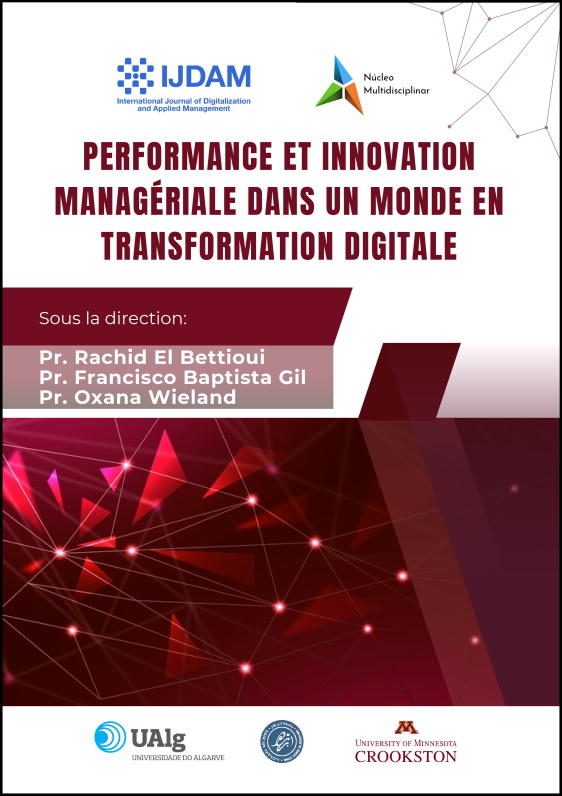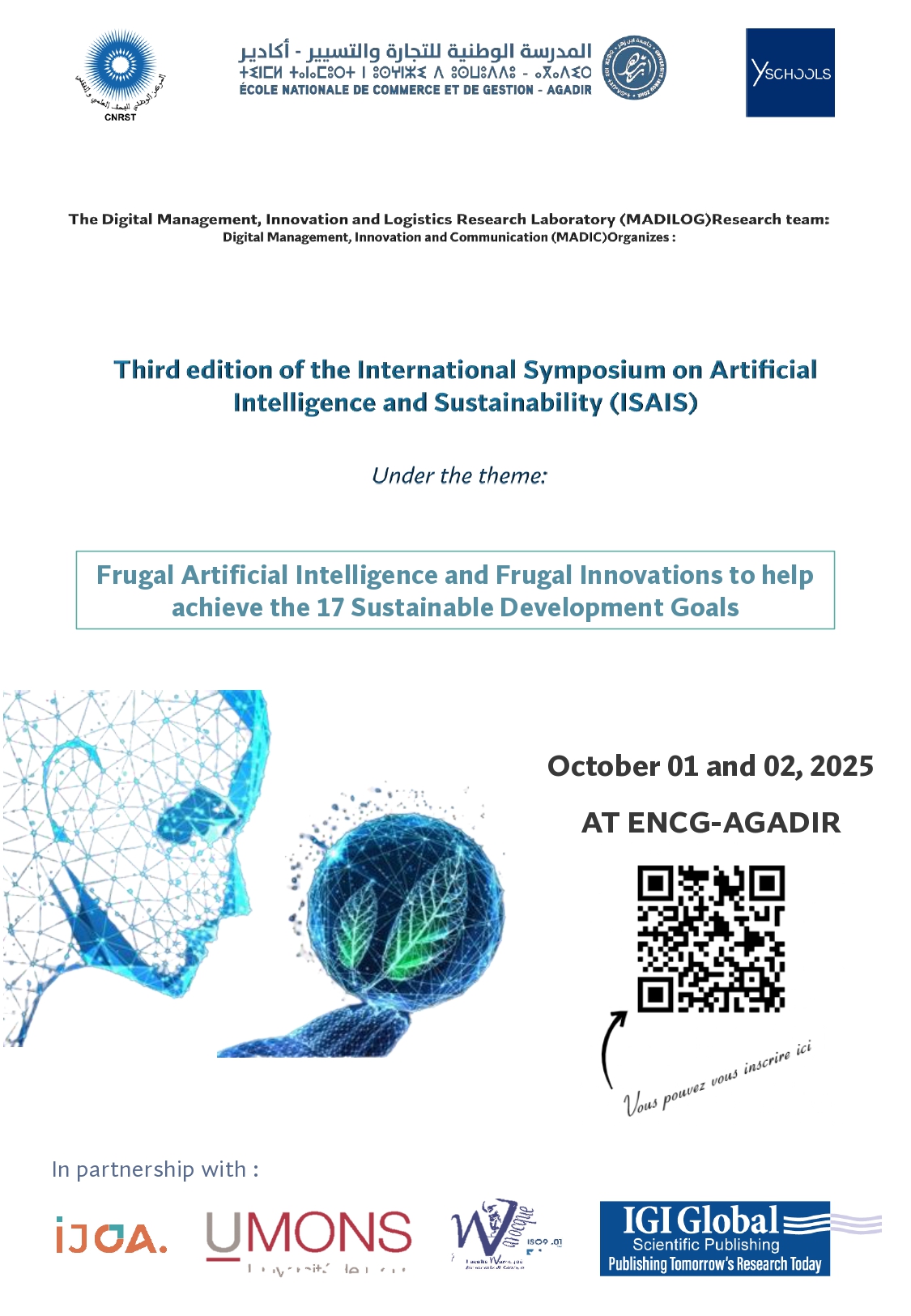Contribution des technologies de l’information à la création de valeur dans le secteur de la santé
une analyse bibliométrique
DOI :
https://doi.org/10.23882/ijdam.24179Mots-clés :
Bibliometric analysis, Contribution, Health information technology, Healthcare, IT, Value. Organizational ResilienceRésumé
Associer de la valeur aux technologies de l'information (TI) est un défi de longue date. Depuis les années 1970, de nombreux chercheurs ont tenté d'explorer cette relation sous différents angles. L'objectif ultime est de fournir des informations qui aideront les organisations de soins de santé à mieux comprendre la valeur générée par les investissements informatiques et à orienter les recherches futures vers des études plus ciblées et efficaces sur la contribution des technologies de l'information sur les soins de santé. Méthodes : Il s'agit de mener une analyse bibliométrique des recherches existantes sur la valeur générée par les technologies de l'information dans les soins de santé pour comprendre comment ces technologies contribuent à la création de valeur. De plus, en utilisant des outils d'analyse contextuelle tels que le logiciel VOSviewer, l'étude vise à catégoriser et à mieux définir le concept de valeur générée par les technologies dans les soins de santé. Résultats : Les résultats révèlent que la valeur générée par les technologies de l’information dans les soins de santé peut être classée en trois catégories distinctes : la valeur organisationnelle, la valeur économique et la valeur sociale. Conclusion : Les résultats de cette discussion pourraient contribuer à une meilleure compréhension des origines et des tendances de la valeur créée par les technologies dans les soins de santé, permettant aux futurs chercheurs de concentrer plus efficacement leurs études sur l'apport de ces technologies sur les soins de santé.
Références
Abdulwahab, S. A., & Zedan, H. S. (2021). Factors Affecting Patient Perceptions and Satisfaction with Telemedicine in Outpatient Clinics. Journal of Patient Experience, 8, 23743735211063780. https://doi.org/10.1177/23743735211063780
Alexander, G. L., Galambos, C., Rantz, M., Shumate, S., Vogelsmeier, A., Popejoy, L., & Crecelius, C. (2022). Value Propositions for Health Information Exchange Toward Improving Nursing Home Hospital Readmission Rates. Journal of Gerontological Nursing, 48(1), 15–20. https://doi.org/10.3928/00989134-20211207-03
Ammenwerth, E., & de Keizer, N. (2004). An inventory of evaluation studies of information technology in health care: Trends in evaluation research 1982-2002. MEDINFO 2004, 1289–1294. https://ebooks.iospress.nl/doi/10.3233/978-1-60750-949-3-1289
Asadi, A. R., Akinremi, T. P., & Said, H. (2024). Information Technology in Healthcare: A Systematic Literature Review. InSITE 2024: Informing Science+ IT Education Conferences, 009. https://www.informingscience.org/Publications/5300
Balta, M., Valsecchi, R., Papadopoulos, T., & Bourne, D. J. (2021). Digitalization and co-creation of healthcare value: A case study in Occupational Health. Technological Forecasting and Social Change, 168, 120785.
Bower, A. G. (2005). The diffusion and value of healthcare information technology. https://policycommons.net/artifacts/4830535/the-diffusion-and-value-of-healthcare-information-technology/5667277/
Caviola, G., Daolio, J., Pellegri, C., Cigarini, F., Braglia, L., Foracchia, M., Mazzini, E., & Cerullo, L. (2023). Learning from adaptations to the COVID-19 pandemic: How teleconsultation supported Cancer care pathways at a Comprehensive Cancer Center in northern Italy. Cancers, 15(9), 2486.
Chaudhry, B., Wang, J., Wu, S., Maglione, M., Mojica, W., Roth, E., Morton, S. C., & Shekelle, P. G. (2006). Systematic Review: Impact of Health Information Technology on Quality, Efficiency, and Costs of Medical Care. Annals of Internal Medicine, 144(10), 742. https://doi.org/10.7326/0003-4819-144-10-200605160-00125
Chen, M., & Decary, M. (2020). Artificial intelligence in healthcare: An essential guide for health leaders. Healthcare Management Forum, 33(1), 10–18. https://doi.org/10.1177/0840470419873123
Claikens, B. L. (2018). Delivering Value from the Digital Integration in Medical Imaging Centers in Healthcare Organizations. Journal of the Belgian Society of Radiology, 102(1). https://www.ncbi.nlm.nih.gov/pmc/articles/PMC6095078/
Collaboration, M. G. of the C. (2016). Methodological expectations of Campbell Collaboration intervention reviews: Conduct standards. Campbell Policies and Guidelines Series, 3. https://onlinelibrary.wiley.com/pb-assets/Campbell%20MECCIR%20Conduct%20standards%20Nov2019-1573120397657.docx
Cowie, M. R., Blomster, J. I., Curtis, L. H., Duclaux, S., Ford, I., Fritz, F., Goldman, S., Janmohamed, S., Kreuzer, J., Leenay, M., Michel, A., Ong, S., Pell, J. P., Southworth, M. R., Stough, W. G., Thoenes, M., Zannad, F., & Zalewski, A. (2017). Electronic health records to facilitate clinical research. Clinical Research in Cardiology, 106(1), 1–9. https://doi.org/10.1007/s00392-016-1025-6
Cunningham, W. E., Ford, C. L., Kinsler, J. J., Seiden, D., Andrews, L., Nakazono, T., & Bell, D. S. (2017). Effects of a laboratory health information exchange intervention on antiretroviral therapy use, viral suppression, and racial/ethnic disparities. JAIDS Journal of Acquired Immune Deficiency Syndromes, 75(3), 290–298.
Dal Mas, F., Piccolo, D., Edvinsson, L., Skrap, M., & D’Auria, S. (2020). Strategy Innovation, Intellectual Capital Management, and the Future of Healthcare: The Case of Kiron by Nucleode. In F. Matos, V. Vairinhos, I. Salavisa, L. Edvinsson, & M. Massaro (Eds.), Knowledge, People, and Digital Transformation (pp. 119–131). Springer International Publishing. https://doi.org/10.1007/978-3-030-40390-4_9
Dang, L. M., Piran, M. J., Han, D., Min, K., & Moon, H. (2019). A survey on internet of things and cloud computing for healthcare. Electronics, 8(7), 768.
Darbyshire, P. (2004). ‘Rage against the machine?’: Nurses’ and midwives’ experiences of using Computerized Patient Information Systems for clinical information. Journal of Clinical Nursing, 13(1), 17–25. https://doi.org/10.1046/j.1365-2702.2003.00823.x
Das, S., Yaylacicegi, U., & Menon, N. M. (2010). The effect of information technology investments in healthcare: A longitudinal study of its lag, duration, and economic value. IEEE Transactions on Engineering Management, 58(1), 124–140.
Davis, J. A., Marino, L., & Aaron, J. (2006). A real options perspective of platform investments in service firms: An application in the nursing home industry. International Journal of Organizational Analysis, 14(2), 107–129.
Dixon, B. E., & Cusack, C. M. (2023). Measuring the value of health information exchange. In Health Information Exchange (pp. 379–398). Elsevier. https://www.sciencedirect.com/science/article/pii/B9780323908023000125
Dranove, D., Garthwaite, C., Li, B., & Ody, C. (2015). Investment subsidies and the adoption of electronic medical records in hospitals. Journal of Health Economics, 44, 309–319.
Febrianti, M., Qurtubi, Q., Jaafar, H. S., Faisol, N., & Zulkeflee, A. (2023). Bibliometric Analysis for Mapping Research on Planogram Using VOSviewer. International Journal of Computing and Digital Systems, 14(1), 667–677.
Galiero, R., Pafundi, P. C., Nevola, R., Rinaldi, L., Acierno, C., Caturano, A., Salvatore, T., Adinolfi, L. E., Costagliola, C., & Sasso, F. C. (2020). The importance of telemedicine during COVID-19 pandemic: A focus on diabetic retinopathy. Journal of Diabetes Research, 2020. https://www.hindawi.com/journals/jdr/2020/9036847/
Grieger, D. L., Cohen, S. H., & Krusch, D. A. (2007). A pilot study to document the return on investment for implementing an ambulatory electronic health record at an academic medical center. Journal of the American College of Surgeons, 205(1), 89–96.
Guo, C., & Chen, J. (2023). Big Data Analytics in Healthcare. In Y. Nakamori (Ed.), Knowledge Technology and Systems (Vol. 34, pp. 27–70). Springer Nature Singapore. https://doi.org/10.1007/978-981-99-1075-5_2
Halsted, M. J., & Froehle, C. M. (2008). Design, Implementation, and Assessment of a Radiology Workflow Management System. American Journal of Roentgenology, 191(2), 321–327. https://doi.org/10.2214/AJR.07.3122
Jara, A. J., Belchi, F. J., Alcolea, A. F., Santa, J., Zamora-Izquierdo, M. A., & Gómez-Skarmeta, A. F. (2010). A Pharmaceutical Intelligent Information System to detect allergies and Adverse Drugs Reactions based on internet of things. 2010 8th IEEE International Conference on Pervasive Computing and Communications Workshops (PERCOM Workshops), 809–812. https://ieeexplore.ieee.org/abstract/document/5470547/
Javaid, M., & Khan, I. H. (2021). Internet of Things (IoT) enabled healthcare helps to take the challenges of COVID-19 Pandemic. Journal of Oral Biology and Craniofacial Research, 11(2), 209–214.
Katarína, Š., Marek, K., Miroslava, R., & Mária, M. (2022). Innovative technologies in precision healthcare. In Biotechnology in Healthcare (pp. 83–102). Elsevier. https://www.sciencedirect.com/science/article/pii/B9780323898379000164
Kitchenham, B., & Charters, S. (2007). Guidelines for performing systematic literature reviews in software engineering. UK.
Kohli, R., Devaraj, S., & Ow, T. T. (2012). Does information technology investment influence a firm’s market value? A case of non-publicly traded healthcare firms. MIS Quarterly, 1145–1163.
Koppel, R., Metlay, J. P., Cohen, A., Abaluck, B., Localio, A. R., Kimmel, S. E., & Strom, B. L. (2005). Role of computerized physician order entry systems in facilitating medication errors. Jama, 293(10), 1197–1203.
Lavissière, A., Sohier, R., & Lavissière, M. C. (2020). Transportation systems in the Arctic: A systematic literature review using textometry. Transportation Research Part A: Policy and Practice, 141, 130–146.
Li, Y., Liu, C., Zou, H., Che, L., Sun, P., Yan, J., Liu, W., Xu, Z., Yang, W., & Dong, L. (2023). Integrated wearable smart sensor system for real-time multi-parameter respiration health monitoring. Cell Reports Physical Science, 4(1), 101191.
Liu, Z., Shi, Y., & Yang, B. (2022). Open innovation in times of crisis: An overview of the healthcare sector in response to the COVID-19 Pandemic. Journal of Open Innovation: Technology, Market, and Complexity, 8(1), 21.
Macke, J., & Genari, D. (2019). Systematic literature review on sustainable human resource management. Journal of Cleaner Production, 208, 806–815.
Manning, J., & McConnell, E. A. (1997). Technology assessment. A framework for generating questions useful in evaluating nursing information systems. Computers in Nursing, 15(3), 141–146.
Randhawa, G. K., Shachak, A., Courtney, K. L., & Kushniruk, A. (2019). Evaluating a post-implementation electronic medical record training intervention for diabetes management in primary care. BMJ Health & Care Informatics, 26(1). https://www.ncbi.nlm.nih.gov/pmc/articles/PMC7062349/
Ria, R. R. P. (2024). Computational Thinking Assessment: Bibliometric Analysis-VOSviewer. Jurnal Simki Pedagogia, 7(1), 305–316.
Roski, J., Bo-Linn, G. W., & Andrews, T. A. (2014). Creating Value In Health Care Through Big Data: Opportunities And Policy Implications. Health Affairs, 33(7), 1115–1122. https://doi.org/10.1377/hlthaff.2014.0147
RPA-C, A. C.-F., Farzad Mostashari, M. D., & Shih, S. C. (2010). The business end of health information technology: Can a fully integrated electronic health record increase provider productivity in a large community practice? The Journal of Medical Practice Management: MPM, 25(6), 342.
Schweitzer, J., & Synowiec, C. (2012). The Economics of eHealth and mHealth. Journal of Health Communication, 17(sup1), 73–81. https://doi.org/10.1080/10810730.2011.649158
Sepulveda, J. L., & Young, D. S. (2013). The ideal laboratory information system. Archives of Pathology and Laboratory Medicine, 137(8), 1129–1140.
Shenoy, P., Ahmed, S., Paul, A., Skaria, T. G., Joby, J., & Alias, B. (2020). Switching to teleconsultation for rheumatology in the wake of the COVID-19 pandemic: Feasibility and patient response in India. Clinical Rheumatology, 39(9), 2757–2762. https://doi.org/10.1007/s10067-020-05200-6
Sun, P., Zhao, Y., Men, J., Ma, Z.-R., Jiang, H.-Z., Liu, C.-Y., & Feng, W. (2023). Application of Virtual and Augmented Reality Technology in Hip Surgery: Systematic Review. Journal of Medical Internet Research, 25, e37599.
Tongkaw, A. (2023). Sensor and actuators for smart healthcare in post-COVID-19 world. In Implementation of Smart Healthcare Systems using AI, IoT, and Blockchain (pp. 29–58). Elsevier. https://www.sciencedirect.com/science/article/pii/B9780323919166000035
Vélez-Díaz-Pallarés, M., Pérez-Menéndez-Conde, C., & Bermejo-Vicedo, T. (2018). Systematic review of computerized prescriber order entry and clinical decision support. American Journal of Health-System Pharmacy, 75(23), 1909–1921.
Wernhart, A., Gahbauer, S., & Haluza, D. (2019). eHealth and telemedicine: Practices and beliefs among healthcare professionals and medical students at a medical university. PloS One, 14(2), e0213067.
Zeltzer, D., Einav, L., Rashba, J., & Balicer, R. D. (2023). The impact of increased access to telemedicine. Journal of the European Economic Association, jvad035.
Zhu, J., & Liu, W. (2020). A tale of two databases: The use of Web of Science and Scopus in academic papers. Scientometrics, 123(1), 321–335. https://doi.org/10.1007/s11192-020-03387-8
Téléchargements
Publiée
Comment citer
Numéro
Rubrique
Licence
(c) Tous droits réservés Rachid OUMLIL, FATIMA MAKHOUKH 2025

Ce travail est disponible sous licence Creative Commons Attribution - Pas d’Utilisation Commerciale 4.0 International.



 Portugal
Portugal











